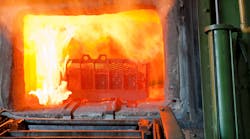Fluid analysis and other laboratory services have become essential for companies with preventive and predictive maintenance programs. Ideally, fluid samples will always reveal clean fluid with the chemical makeup to indicate a healthy hydraulic system. This is what everyone wants to hear, but these services pay for themselves many times over when potential problems are detected before they occur. But beyond the reduction in downtime and maintenance costs, fluid analysis can also avert catastrophic events.
Tony Noblit, of Houghton International, says companies use fire-resistant hydraulic fluids in applications where the potential for fire exists. “Using mineral-based hydraulic oil in fire-hazard applications can be dangerous, resulting in a fire and propagation of flame as the mineral-based oil comes in contact with an ignition source. One of our customers, a steel mill, submitted a sample of our polyol ester-type fire-resistant hydraulic fluid for routine analysis from various hydraulic equipment. Our standard fluid analysis revealed that the samples were in good condition, except one. Our testing revealed that the sample had a specific gravity of 0.900. Our polyol ester fluid typically has a specific gravity of 0.920, so something had contaminated the polyol ester fluid in that particular system, causing the specific gravity to drop.
“The first thought was that mineral oil was the most likely contaminant. Mineral-based hydraulic oils typically have a specific gravity of 0.86 to 0.88. Mineral oil is completely miscible and compatible with our polyol ester-type fire-resistant hydraulic fluid, so mixing the fluids would not be apparent by visual examination. We called on the duties of our analytical service laboratory to further investigate this issue.
“They used Fourier Transform Infrared Spectroscopy (FTIR) to identify that oil was, indeed, the culprit contaminating the polyol ester fluid. The next step in the analysis was to determine how much mineral oil was contaminating the polyol ester fluid. Column chromatography was used to find the amount of mineral oil contaminating the fluid. Column chromatography is used to purify individual chemical compounds from mixtures. The lab found that the polyol ester fluid was contaminated with 16% mineral oil.
“The fluid analysis helped the customer advert disaster. Had the contaminated polyol ester fluid come in contact with an ignition source, a significant fire could have resulted. We contacted our technical representative servicing the account and told him the severity of the situation. The customer was extremely grateful that the sample analysis prevented a potential disaster. Follow-up investigation discovered that a maintenance person had inadvertently added an ISO viscosity grade 68 hydraulic oil to the system. The steel mill implemented a new process to prevent this event from reoccurring.
This discussion was provided by Houghton International, Valley Forge, Pa. For more information, call (800) 666-4684.


